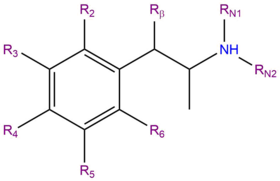2C-D
| 2C-D | |||||||||||||||||||||||||||||||||
|---|---|---|---|---|---|---|---|---|---|---|---|---|---|---|---|---|---|---|---|---|---|---|---|---|---|---|---|---|---|---|---|---|---|
 |
|||||||||||||||||||||||||||||||||
| Chemical Nomenclature | |||||||||||||||||||||||||||||||||
| Common names | 2C-D, 2C-M, LE-25 | ||||||||||||||||||||||||||||||||
| Substitutive name | 2,5-Dimethoxy-4-methylphenethylamine | ||||||||||||||||||||||||||||||||
| Systematic name | 1-(2,5-Dimethoxy-4-methylphenyl)-2-aminoethane | ||||||||||||||||||||||||||||||||
| Class Membership | |||||||||||||||||||||||||||||||||
| Psychoactive class | Psychedelic | ||||||||||||||||||||||||||||||||
| Chemical class | Phenethylamine | ||||||||||||||||||||||||||||||||
| Routes of Administration | |||||||||||||||||||||||||||||||||
|
|||||||||||||||||||||||||||||||||
| Interactions | |||||||||||||||||||||||||||||||||
| Summary sheet: 2C-D |
2C-D (2,5-dimethoxy-4-methylphenethylamine, also known as 2C-M) is a phenethylamine psychedelic drug of the 2C-x family that is sometimes used as an entheogen. It was first synthesized in 1970 by a team from the Texas Research Institute of Mental Sciences,[1] and its activity was subsequently investigated in humans by Alexander Shulgin[2]. The full name of the chemical is 2,5-dimethoxy-4-methylphenethylamine. In his book PiHKAL (Phenethylamines i Have Known And Loved), Shulgin lists the dosage range as being from 20 to 60 mg and many people recommend higher doses. Lower doses (generally 10 mg or less) of 2C-D have been explored as a potential nootropic, albeit with mixed results. 2C-D is generally taken orally, though may be insufflated (i.e., taken nasally). Insufflating tends to cause intense pain, however, and the dosage level is usually much lower, typically in the region of 1 to 15 mg.
Not much information is known about the toxicity of 2C-D, as no major studies have been conducted. According to Shulgin, the effects of 2C-D typically last for 4–6 hours. Shulgin himself referred to this substance as a “pharmacological tofu,” meaning that when mixed with other substances, it can extend or potentiate their effects without coloring the experience too much, in a manner similar to how tofu absorbs the flavors of sauces or spices it is cooked with. Some people have claimed 2C-D is relatively uninteresting on its own, but many other users have strongly disagreed with this assessment and believe that 2C-D is a true psychedelic in its own right.
In modern times, it is used as a recreational drug and an entheogen, rarely sold on the streets and almost exclusively obtained as a grey area research chemical through the use of online vendors. Therefore, it is relatively uncommon and has only a short history of human use.
Many users report that 2C-D is calmer and much more sedating than other closely related psychedelic phenethylamines.
Chemistry

2C-D or 2,5-dimethoxy-4-methylphenethylamine is a substituted phenethylamine featuring a phenyl ring bound to an amino (NH2) group through an ethyl chain. 2C-D contains methoxy functional groups CH3O- attached to carbons R2 and R5 as well as a methyl group attached to carbon R4 of the phenyl ring. 2C-D belongs to the 2C family of phenethylamines which contain methoxy groups on the 2 and 5 positions of the benzene ring.Cite error: Closing </ref> missing for <ref> tag
- United Kingdom: 2C-D is a Class A controlled substance as it is covered by the phenethylamine derivatives clause of the Misuse of Drugs Act of 1971.
- Sweden: 2C-D is classified as a "health hazard" as of March 1, 2005 in their regulation SFS 2005:26, making it illegal to sell or possess.[3]
- Japan: 2C-D is controlled by the Pharmaceutical Affairs Law in Japan, making it illegal to possess or sell. [4]
- Australia: Australia has a blanket ban over all substituted phenethylamines including the entire 2C-X family.[5]
- Denmark: 2C-D is added to the list of Schedule B controlled substances.[6]
See also
External links
References
- ↑ Amphetamine analogs. II. Methylated phenethylamines | https://www.ncbi.nlm.nih.gov/pubmed/5412084
- ↑ 2,5-Dimethoxy-4-chlorophenethylamine (IsomerDesign / PiHKAL) http://isomerdesign.com/PiHKAL/read.php?id=22
- ↑ Svensk författningssamling | http://www.notisum.se/rnp/sls/sfs/20050026.pdf
- ↑ Analytical Data of Designated Substances (Shitei-Yakubutsu) Controlled by the Pharmaceutical AŠairs Law in Japan, Part I: GC-MS and LC-MS | https://www.erowid.org/references/texts/show/7395docid7635
- ↑ New Psychoactive Substances (National Drug and Alcohol Research Centre 2014) | https://comorbidity.edu.au/sites/default/files/cre/page/New%20Psychoactive%20Substances.pdf
- ↑ https://www.retsinformation.dk/Forms/R0710.aspx?id=137169